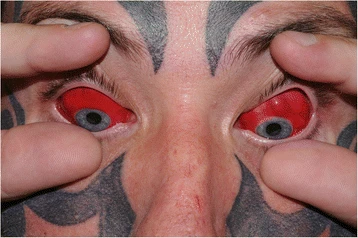There are plenty of other good ways to look badass that don’t involve jeopardizing your eyesight.

How eye tattoos started
Tattooing is one of the oldest forms of art in human history. It’s been done since at least the Neolithic and is present in several ancient cultures. But that’s not to say tattooing hasn’t changed.
We now have access to several types of professional equipment, including some that hurt less or that don’t even use needles. Tattoos have become more intricate and elaborate than ever before, and there’s always someone ready to go the extra distance to get a unique tattoo; but sometimes, they go too far.
The first three eye tattoos were described in 2007 in an article in Body Modification Ezine. All of them were carried out by a tattoo artist going by the name of Luna Cobra (Howard “Howie” Rollins), who experimented on willing volunteers.
Two procedures were tested. The first one involved covering the needle with ink and simply puncturing the eye. This method turned out to be unsuccessful (and already if your experimenting tattoo artist deems puncturing your eye as ‘unsuccessful’, you should probably start asking some questions. The second procedure, in which the sclera (the part of the eye that surrounds the cornea) is injected with dye, worked.
The original article, which was written by one of the three volunteers, does mention the risks and possible complications (which include blindness and eye loss) but goes on to say that in their particular case, there were no major aftereffects.
“I really have to emphasize again that the procedure was extensively researched and done by people who were aware of the risks and possible complications and that it should not be casually attempted. Now that this experiment has been started, please wait for us to either heal or go blind before trying it,” the article mentions.
However, the “research” the author mentions isn’t exactly scientific research. There’s no peer-reviewed paper (that we could find at least) that documents the procedure or explains how it can be safely done — because there’s no guarantee that it will be safe.
Even so, according to Allure, Cobra went on to “safely” tattoo hundreds of eyeballs, and although he feels more comfortable with the procedure now, he recommends people get quality contacts and wear those instead of going for a real eye tattoo.
What’s in an eye tattoo
For the sake of clarity, “eye tattoos” here refer to scleral tattoos. Corneal tattoos, which is the practice of tattooing the cornea of the human eye (either for aesthetic reasons following an accident, or for the purpose of improving eyesight in some conditions) is a completely different procedure and we’re not talking about that here.
The first eye tattoos were actual inspired by Dune. In the epic book and movie adaptation, the native inhabitants of the planet Dune have completely blue eyes — including the sclera and the iris.

To achieve this coloration, the dye is injected not into the tissue, but rather between two layers of the eye, where it spreads. A single ink injection covers about a quarter of the eye, so several injections are needed to completely cover the entire eye surface. But once it’s injected, it can also cause chronic inflammation of the eye, and if it’s not injected exactly in the right place, the needle can also perforate the eye.
Putting any needle into your eye is a huge ‘no-no’, especially as the one doing it is not a medical practitioner. Add in the risk of injecting a foreign substance into your eye, and you end up with a recipe for disaster. Cobra himself admits that a lot of people are getting hurt because of unsafe eye tattoos, and although he’d like to “continue the art,” he would advocate a complete ban on the procedure.
In fact, some places have banned it. Scleral tattooing is illegal in Oklahoma and the Canadian provinces of Ontario and Saskatchewan. However, in most places, they fall under the same legislation as other tattoos.
Some of the problems that can be associated with eye tattoos include:
- Decreased vision or complete blindness;
- Retinal detachment;
- Infection from the injection or ink;
- Ongoing inflammation of the eye;
- Sensitivity to light;
- Feeling like something is in your eye, all the time;
- Loss of the entire eye.
Eye tattoo studies

In the medical literature, there are few studies that look at eye tattoos. The ones that do exist are generally case studies — and they’re cases of when something’s gone wrong. For instance, a 2015 report notes that we don’t even know the long-term consequences of the procedure, and the short-term ones can also be very dangerous.
“Episcleral tattooing is carried out by individuals with no medical training,” the report concludes. “The short-term complications reported so far include: headaches, severe photophobia, persistent foreign body sensation, and migration of ink staining. More serious short-term risks such as infection, globe penetration, and peri-ocular haemorrhage could occur.”
“For now we can only speculate as to the long-term consequences, but these may include carcinogenic change or granulomatous inflammation. We feel that the potential risks of the procedure should be communicated more widely to those body modification practitioners undertaking it. This practice could result in more serious presentations to acute eye services in the future.”
Similar findings came from a 2017 study that documented two Mexican men who, after receiving eye tattoos, presented to the hospital with complications. The researchers’ conclusions were even stronger, calling for a ban on this procedure
“Eyeball tattoos are done by non-ophthalmic trained personnel, which increases the risk of serious ocular complications like globe penetration and endophthalmitis,” the study notes.
“Long-term effects on the eyes and vision are uncertain, but in the worst case scenario could include the loss of vision or the eye. Regulations prohibiting the practice of these procedures are required, because despite warnings of multiple health risks, more people are looking to get this procedure nowadays.”
A 2021 review of all existing cases in the medical literature notes that although rare, the practice is still very dangerous. The review also cautions that there are possible long-term risks that may have not kicked in yet.
“One of the more concerning consequences of scleral tattooing could be the masking of underlying ocular surface malignancy, though this has not yet been reported. We caution patients against the practice of scleral tattooing due to the very real danger of permanent blindness or loss of eye and advise patients to seek medical attention immediately for any adverse events.”
Why you shouldn’t get an eye tattoo
If it’s not clear by now, let’s be clear: you shouldn’t get an eye tattoo because it’s dangerous. You’re essentially allowing an artist (tattoo artist, body modification artist, whatever you prefer to call them) to poke a needle into your eye, several times, and inject dye.
The risk is very real. Every few months, there’s a story in the news about an eye tattoo gone wrong, and when it goes wrong, it’s really wrong. If you want to see just how wrong, here’s a video of a patient whose eye had to be ultimately surgically removed.
There are plenty of safer ways to decorate your body. Having colored eyes can be cool, but there are safe contacts you can wear — and you can take them out anytime you’d like. Opting to dye your eye is as risky as it sounds, and the damage can be very real.







